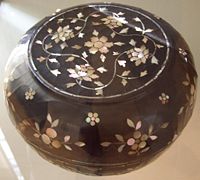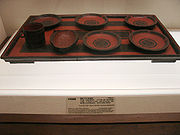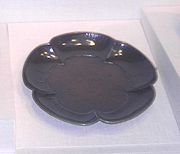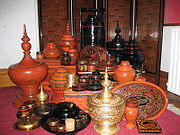
Lacquerware
Encyclopedia


Lacquer
In a general sense, lacquer is a somewhat imprecise term for a clear or coloured varnish that dries by solvent evaporation and often a curing process as well that produces a hard, durable finish, in any sheen level from ultra matte to high gloss and that can be further polished as required...
. The lacquer is sometimes inlaid or carved. Lacquerware includes boxes, tableware, buttons and even coffins painted with lacquer in cultures mostly in the Eastern Hemisphere.
History


Shang Dynasty
The Shang Dynasty or Yin Dynasty was, according to traditional sources, the second Chinese dynasty, after the Xia. They ruled in the northeastern regions of the area known as "China proper" in the Yellow River valley...
(ca. 1600–1046 BCE), the sophisticated techniques used in the lacquer process were first developed and it became a highly artistic craft, although various prehistoric lacquerwares have been unearthed in China dating back to the Neolithic
Neolithic
The Neolithic Age, Era, or Period, or New Stone Age, was a period in the development of human technology, beginning about 9500 BC in some parts of the Middle East, and later in other parts of the world. It is traditionally considered as the last part of the Stone Age...
period and objects with lacquer coating found in Japan dating to the late Jomon period
Jomon period
The is the time in Japanese prehistory from about 14,000 BC to 300 BC.The term jōmon means "cord-patterned" in Japanese. This refers to the pottery style characteristic of the Jōmon culture, and which has markings made using sticks with cords wrapped around them...
. The earliest extant lacquer object, a red wooden bowl, was unearthed at a Hemudu culture
Hemudu culture
The Hemudu culture was a Neolithic culture that flourished just south of the Hangzhou Bay in Jiangnan in modern Yuyao, Zhejiang, China. The site at Hemudu, 22 km north-west of Ningbo, was discovered in 1973...
(ca. 5000-4500 BCE) site in China.Wang, Zhongshu. (1982). Han Civilization. Translated by K.C. Chang and Collaborators. New Haven and London: Yale University Press. Page 80. ISBN 0300027230. By the Han Dynasty
Han Dynasty
The Han Dynasty was the second imperial dynasty of China, preceded by the Qin Dynasty and succeeded by the Three Kingdoms . It was founded by the rebel leader Liu Bang, known posthumously as Emperor Gaozu of Han. It was briefly interrupted by the Xin Dynasty of the former regent Wang Mang...
(206 BCE – 220 CE), special administrations were established to organize and divide labour for the expanding lacquer production in China.
Elaborate incised decorations were known to be used in a number of Chinese lacquerware during the Han Dynasty. In the Tang Dynasty
Tang Dynasty
The Tang Dynasty was an imperial dynasty of China preceded by the Sui Dynasty and followed by the Five Dynasties and Ten Kingdoms Period. It was founded by the Li family, who seized power during the decline and collapse of the Sui Empire...
(618–907), Chinese lacquerware saw a new style marked by the use of sheets of gold or silver made in various shapes, such as birds, animals, and flowers. These were affixed onto the surface of the lacquer body, after which new layers of lacquer were applied, dried, and then ground away, so the surface could be polished to reveal the golden or silvery patterns beneath. Such techniques were time-consuming and costly, but these lacquerware were considered highly refined. Several decorative techniques gradually evolved further after the 10th century, such as qiangjin (engraving filled with gold), diaotian or tianqi (inlaid lacquer of a different colour), and diaoqi (carved lacquer). The art of inlaying lacquer with mother-of-pearl was intensively developed during the Song Dynasty
Song Dynasty
The Song Dynasty was a ruling dynasty in China between 960 and 1279; it succeeded the Five Dynasties and Ten Kingdoms Period, and was followed by the Yuan Dynasty. It was the first government in world history to issue banknotes or paper money, and the first Chinese government to establish a...
(960–1279). However, during the Song, the artistic craft also made use of inlaid gold in a process of which is to engrave intricate patterns in the lacquer surface and to fill the intaglio
Intaglio
Intaglio are techniques in art in which an image is created by cutting, carving or engraving into a flat surface and may also refer to objects made using these techniques:* Intaglio , a group of printmaking techniques with an incised image...
with gold powder.
The knowledge of the Chinese methods of the lacquer process spread from China during the Han
Han Dynasty
The Han Dynasty was the second imperial dynasty of China, preceded by the Qin Dynasty and succeeded by the Three Kingdoms . It was founded by the rebel leader Liu Bang, known posthumously as Emperor Gaozu of Han. It was briefly interrupted by the Xin Dynasty of the former regent Wang Mang...
, Tang
Tang Dynasty
The Tang Dynasty was an imperial dynasty of China preceded by the Sui Dynasty and followed by the Five Dynasties and Ten Kingdoms Period. It was founded by the Li family, who seized power during the decline and collapse of the Sui Empire...
and Song
Song Dynasty
The Song Dynasty was a ruling dynasty in China between 960 and 1279; it succeeded the Five Dynasties and Ten Kingdoms Period, and was followed by the Yuan Dynasty. It was the first government in world history to issue banknotes or paper money, and the first Chinese government to establish a...
dynasties, eventually it was introduced to Korea
Korea
Korea ) is an East Asian geographic region that is currently divided into two separate sovereign states — North Korea and South Korea. Located on the Korean Peninsula, Korea is bordered by the People's Republic of China to the northwest, Russia to the northeast, and is separated from Japan to the...
, Japan
Japan
Japan is an island nation in East Asia. Located in the Pacific Ocean, it lies to the east of the Sea of Japan, China, North Korea, South Korea and Russia, stretching from the Sea of Okhotsk in the north to the East China Sea and Taiwan in the south...
, Southeast and South Asia. In Japan
Japan
Japan is an island nation in East Asia. Located in the Pacific Ocean, it lies to the east of the Sea of Japan, China, North Korea, South Korea and Russia, stretching from the Sea of Okhotsk in the north to the East China Sea and Taiwan in the south...
, the art of lacquerware-making came along with Buddhism and other cultural artefacts from China via Korean Peninsula
Korean Peninsula
The Korean Peninsula is a peninsula in East Asia. It extends southwards for about 684 miles from continental Asia into the Pacific Ocean and is surrounded by the Sea of Japan to the south, and the Yellow Sea to the west, the Korea Strait connecting the first two bodies of water.Until the end of...
during the 8th century, and "carved lacquerware" came to Japan from Ming Dynasty China during the 14th century. One of the earliest Japanese techniques for decorating the lacquer surface was, besides painting simple designs, the gold and silver foil inlay of the Nara period
Nara period
The of the history of Japan covers the years from AD 710 to 794. Empress Gemmei established the capital of Heijō-kyō . Except for 5 years , when the capital was briefly moved again, it remained the capital of Japanese civilization until Emperor Kammu established a new capital, Nagaoka-kyō, in 784...
(710–784). This technique was transmitted from China during the Tang Dynasty
Tang Dynasty
The Tang Dynasty was an imperial dynasty of China preceded by the Sui Dynasty and followed by the Five Dynasties and Ten Kingdoms Period. It was founded by the Li family, who seized power during the decline and collapse of the Sui Empire...
(618–907). Many ancient lacquer artefacts of East Asia can be found in private collections and museums, such as the Freer Gallery of Art
Freer Gallery of Art
The Freer Gallery of Art joins the Arthur M. Sackler Gallery to form the Smithsonian Institution's national museums of Asian art. The Freer contains art from East Asia, South Asia, Southeast Asia, the Islamic world, the ancient Near East, and ancient Egypt, as well as a significant collection of...
in Washington D.C.
Burmese lacquerware
Yun-de is lacquerware in BurmeseBurmese language
The Burmese language is the official language of Burma. Although the constitution officially recognizes it as the Myanmar language, most English speakers continue to refer to the language as Burmese. Burmese is the native language of the Bamar and related sub-ethnic groups of the Bamar, as well as...
, and the art is called Pan yun (:my:ပန်းယွန်း) . The lacquer is the sap tapped from the varnish tree Melanorrhoea usitatissima or Thitsee that grows wild in the forests of Myanmar
Myanmar
Burma , officially the Republic of the Union of Myanmar , is a country in Southeast Asia. Burma is bordered by China on the northeast, Laos on the east, Thailand on the southeast, Bangladesh on the west, India on the northwest, the Bay of Bengal to the southwest, and the Andaman Sea on the south....
(formerly Burma). It is straw-coloured but turns black on exposure to air. When brushed in or coated on, it forms a hard glossy smooth surface resistant to a degree effects of exposure to moisture or heat.
History
BayinnaungBayinnaung
Bayinnaung Kyawhtin Nawrahta was the third king of the Toungoo dynasty of Burma . During his 30-year reign, which has been called the "greatest explosion of human energy ever seen in Burma", Bayinnaung assembled the largest empire in the history of Southeast Asia, which included much of modern day...
's conquest and subjugation in 1555-1562 of Manipur
Manipur
Manipur is a state in northeastern India, with the city of Imphal as its capital. Manipur is bounded by the Indian states of Nagaland to the north, Mizoram to the south and Assam to the west; it also borders Burma to the east. It covers an area of...
, Bhamo
Bhamo
Bhamo is a city of Kachin State in northernmost part of Myanmar, located 186 km south from the capital city of Myitkyina. It is on the Ayeyarwady River. It lies within 65 km of the border with Yunnan Province, China. The population consists of Chinese and Shan, with Kachin peoples in...
, Zinme (Chiang Mai
Chiang Mai
Chiang Mai sometimes written as "Chiengmai" or "Chiangmai", is the largest and most culturally significant city in northern Thailand. It is the capital of Chiang Mai Province , a former capital of the Kingdom of Lanna and was the tributary Kingdom of Chiang Mai from 1774 until 1939. It is...
), Linzin (Lan Xang
Lan Xang
The Lao kingdom of Lan Xang Hom Kao was established in 1354 by Fa Ngum.Exiled as an infant to Cambodia, Prince Fa Ngum of Xieng Dong Xieng Thong married a daughter of the Khmer king. In 1349 he set out from Angkor at the head of a 10,000-man army to establish his own country...
), and up the Taping and Shweli rivers in the direction of Yunnan
Yunnan
Yunnan is a province of the People's Republic of China, located in the far southwest of the country spanning approximately and with a population of 45.7 million . The capital of the province is Kunming. The province borders Burma, Laos, and Vietnam.Yunnan is situated in a mountainous area, with...
brought back large numbers of skilled craftsmen into Burma. It is thought that the finer sort of Burmese lacquerware, called Yun, was introduced during this period by imported artisans belonging to the Yun or Laos
Laos
Laos Lao: ສາທາລະນະລັດ ປະຊາທິປະໄຕ ປະຊາຊົນລາວ Sathalanalat Paxathipatai Paxaxon Lao, officially the Lao People's Democratic Republic, is a landlocked country in Southeast Asia, bordered by Burma and China to the northwest, Vietnam to the east, Cambodia to the south and Thailand to the west...
Shan tribes of the Chiang Mai region.
Manufacture and design

Palace scenes, scenes from the Jataka
Jataka
The Jātakas refer to a voluminous body of literature native to India concerning the previous births of the Buddha....
tales, and the signs of the Burmese Zodiac
Zodiac
In astronomy, the zodiac is a circle of twelve 30° divisions of celestial longitude which are centred upon the ecliptic: the apparent path of the Sun across the celestial sphere over the course of the year...
are popular designs and some vessels may be encrusted with glass mosaic or semi-precious stones in gold relief. The objects are all handmade and the designs and engraving done free-hand. It may take three to four months to finish a small vessel but perhaps over a year for a larger piece. The finished product is a result of teamwork and not crafted by a single person.
Forms
The most distinctive vessel is probably a rice bowl on a stem with a spired lid for monks called hsun ok. Lahpet ok is a shallow dish with a lid and has a number of compartments for serving lahpetLahpet
Lahpet, also spelt laphet :"Of all the fruit, the mango's the best; Of all the meat, pork's the best; Of all the leaves, lahpets the best".-Etymology:...
(pickled tea) with its various accompaniments. Stackable tiffin-carriers fastened with a single handle or hsun gyaink are usually plain red or black. Daunglahn are low tables for meals and may be simple broad based or have three curved feet in animal or floral designs with a lid. Water carafes or yeidagaung with a cup doubling as a lid, and vases are also among lacquerware still in use in many monasteries.
Various round boxes with lids, small and large, are known as Yun-It including ones for paan
Paan
Paan, from the word pān is an Indian, Pakistani, Uttarvarshi and Southeast Asian tradition of chewing betel leaf with areca nut and slaked lime paste, and katha brown powder paste, with many regional and local variations...
called Kun-It (betel boxes). Yun titta are rectangular boxes for storing various articles including peisa or palm leaf manuscripts when they are called sadaik titta. Pedestal dishes or small trays with a stem with or without a lid are known as kalat for serving delicacies or offering flowers to royalty or the Buddha
Gautama Buddha
Siddhārtha Gautama was a spiritual teacher from the Indian subcontinent, on whose teachings Buddhism was founded. In most Buddhist traditions, he is regarded as the Supreme Buddha Siddhārtha Gautama (Sanskrit: सिद्धार्थ गौतम; Pali: Siddhattha Gotama) was a spiritual teacher from the Indian...
. Theatrical troupes and musicians have their lacquerware in costumes, masks, head-dresses, and musical instruments, some of them stored and carried in lacquer trunks. Boxes in the shape of a pumpkin or a bird such as the owl, which is believed to bring luck, or the hintha
Hamsa bird
The Hamsa is an aquatic bird, often considered to be a goose or sometimes a swan. It is used in Indian and Southeast Asian culture as a symbol and a decorative element.-Identification :...
(Brahmani goose) are common too. Screens and small polygonal tables are also made for the tourist trade today.
Industry
BaganBagan
Bagan , formerly Pagan, is an ancient city in the Mandalay Region of Burma. Formally titled Arimaddanapura or Arimaddana and also known as Tambadipa or Tassadessa , it was the capital of several ancient kingdoms in Burma...
is the major centre for the lacquerware industry where the handicraft has been established for nearly two centuries, and still practised in the traditional manner. Here a government school of lacquerware was founded in the 1920s. Since plastics, porcelain and metal have superseded lacquer in most everyday utensils, it is today manufactured in large workshops mainly for tourists who come to see the ancient temples of Bagan. At the village of Kyaukka near Monywa
Monywa
Monywa is a city in Sagaing Division, Myanmar, located 136 km northwest of Mandalay on the eastern bank of the River Chindwin.-Transport:...
in the Chindwin
Chindwin River
The Chindwin River is a river in Burma , and the largest tributary of the country's chief river the Ayeyarwady . It flows entirely within Burma and is known as Ning-thi to the Manipuris.-Source:...
valley, however, sturdy lacquer utensils are still produced for everyday use mainly in plain black.
A decline in the number of visitors combined with the cost of resin, which has seen a 40 fold rise in 15 years, has led to the closure of over two thirds of more than 200 lacquerware workshops in Bagan.

Japanese Lacquerware
Lacquerware is called by the Sinitic compound shikki (漆器) in Japanese. The native term for lacquer is urushi (漆), source of the English hybrid word "urushiolUrushiol
Urushiol is an oily organic allergen found in plants of the family Anacardiaceae, especially Toxicodendron spp. . It causes an allergic skin rash on contact, known as urushiol-induced contact dermatitis...
". Etymologically, urushi may be related to the words uruwashii ("beautiful") or uruoi ("watered", "profitable", "favoured"), due speculatively to their value or shiny appearance, or perhaps the humidifying rooms used in production of lacquered wares.
Urushi is applied to wood or paper substrates to form urushi-wares.
The 17th-century term "japanning
Japanning
Japanning describes the European imitation of Asian lacquerwork, originally used on furniture. The word originated in the 17th century.- Japanned :Japanned is most often a heavy black lacquer, almost like enamel paint...
" refers to a range of techniques to imitate various Asian lacquerware, but especially those developed in Europe and Great Britain to resemble lacquerware imported from the Orient. These commonly employed a black, oil-based varnish, ("Japan black", "Brunswick black", etc.), on wood and later metal substrates, eventually finding a variety of 19th- and early-20th-century industrial applications. Japan black was famously Ford's preferred automotive finish until the advent of quick-drying, variously coloured nitrocellulose lacquers.
History and Regional Production
Although there is some evidence of cultivation of the lacquer treeLacquer Tree
Toxicodendron vernicifluum , also known with the common name Chinese lacquer tree, is a species of genus Toxicodendron that grows in East Asia, in regions of China, Korea and Japan...
in prehistoric times, (perhaps for extraction of urushiol adhesives), the art of lacquerware most likely arrived in Japan from from China via Korean Peninsula
Korean Peninsula
The Korean Peninsula is a peninsula in East Asia. It extends southwards for about 684 miles from continental Asia into the Pacific Ocean and is surrounded by the Sea of Japan to the south, and the Yellow Sea to the west, the Korea Strait connecting the first two bodies of water.Until the end of...
along with Buddhism
Buddhism
Buddhism is a religion and philosophy encompassing a variety of traditions, beliefs and practices, largely based on teachings attributed to Siddhartha Gautama, commonly known as the Buddha . The Buddha lived and taught in the northeastern Indian subcontinent some time between the 6th and 4th...
and the Chinese writing system in the Asuka
Asuka period
The , was a period in the history of Japan lasting from 538 to 710 , although its beginning could be said to overlap with the preceding Kofun period...
and Nara period
Nara period
The of the history of Japan covers the years from AD 710 to 794. Empress Gemmei established the capital of Heijō-kyō . Except for 5 years , when the capital was briefly moved again, it remained the capital of Japanese civilization until Emperor Kammu established a new capital, Nagaoka-kyō, in 784...
s (6th through 8th centuries).
By the Kamakura period
Kamakura period
The is a period of Japanese history that marks the governance by the Kamakura Shogunate, officially established in 1192 in Kamakura by the first shogun Minamoto no Yoritomo....
(1185–1333), Japanese craftsman under the influence of the Song Dynasty
Song Dynasty
The Song Dynasty was a ruling dynasty in China between 960 and 1279; it succeeded the Five Dynasties and Ten Kingdoms Period, and was followed by the Yuan Dynasty. It was the first government in world history to issue banknotes or paper money, and the first Chinese government to establish a...
arts focused on carving Buddhist imagery into thick coats of lacquer, (Kamakura-bori
Kamakura-bori
is a form of lacquerware from Kamakura, Japan. It is made by carving patterns in wood, then lacquering it with layers of red, blue, yellow or other colors...
). Japanese craftsman at this time began applying a thin lacquer coat to carved wood substrates, in this way reducing production times and making lacquerware available beyond temples to samurai
Samurai
is the term for the military nobility of pre-industrial Japan. According to translator William Scott Wilson: "In Chinese, the character 侍 was originally a verb meaning to wait upon or accompany a person in the upper ranks of society, and this is also true of the original term in Japanese, saburau...
and merchants.
Today, lacquerware is produced throughout the Japanese archipelago, with many regional techniques and variations. Besides the very old Kamakura tradition mentioned above, (and still alive today), the port town of Wajima
Wajima, Ishikawa
is a city located in Ishikawa, Japan.As of 2008, the city has an estimated population of 31,532 and the density of 74 persons per km². The total area is 426.25 km².The city was founded on March 31, 1954....
provides a good example of regional lacquerware. Wajima-nuri, dating back to the 16th century, is characterized by use of the elm-like Japanese zelkova, (keyaki 欅), powdered earth, and delicate features formed from cloth. (See the Japanese article, 輪島塗.)
(A more complete list of regional lacquer traditions is available in the Japanese article.)
External links
- "Lacquerware Stories" at the Kyoto National MuseumKyoto National MuseumThe is one of the three formerly imperially-mandated art museums in Japan. The museum is located in Higashiyama Ward in Kyoto. The collections of the Kyoto National Museum focus on pre-modern Japanese and Asian art....
. - Kelly, Kristin. 2001. The Extraordinary Museums of Southeast Asia, pp. 49–54. Harry Abrams, Inc.: New York. http://books.google.com/books?id=t06YAAAACAAJ&dq=THe+extraordinary+museums+of+southeast+asia&ei=1j2dR-TrIYjssQPa7c2pCg

